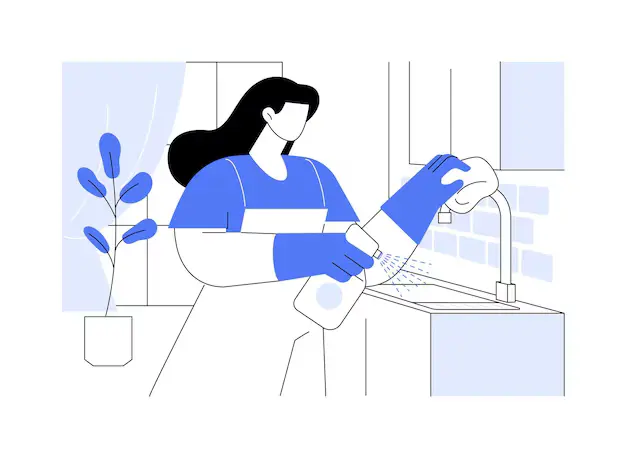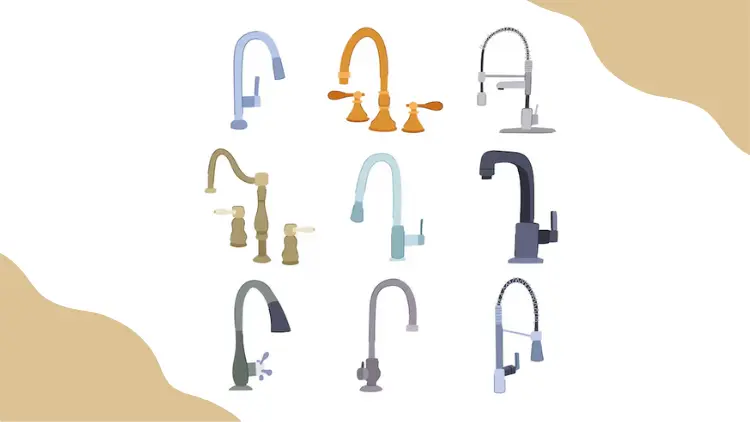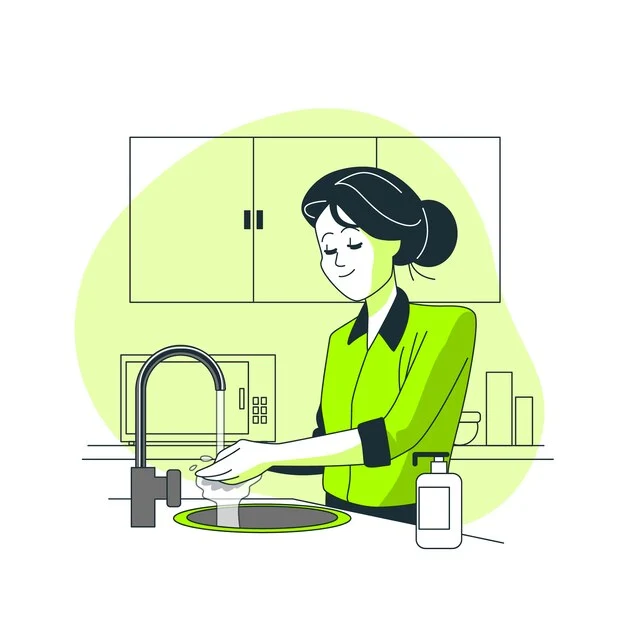Introduction: Why Cleaning Your Kitchen Faucet Head Matters
When it comes to maintaining a clean and healthy kitchen, most homeowners focus on countertops, sinks, and appliances. However, one area that often gets overlooked is the kitchen faucet head. Over time, hard water stains, mineral deposits, soap scum, and even bacteria can accumulate, affecting water flow and hygiene.
Learning how to clean your kitchen faucet head not only helps restore its appearance but also ensures safe water for cooking and cleaning. This guide will walk you through simple DIY effective methods using household ingredients like vinegar, baking soda, and more—so your kitchen faucet can shine and function like new.
Need of Cleaning Kitchen Faucet Head

Regular maintenance of your kitchen faucet is more than just an aesthetic task—it plays a key role in maintaining a hygienic and efficient kitchen. Over time, faucet heads accumulate mineral deposits, hard water stains, soap scum, and even bacteria. This buildup can impact the water flow, reduce pressure, and create an ideal environment for mold and germs to thrive.
Knowing how to clean kitchen faucet head is essential for preventing these issues. A clean faucet ensures smoother water flow, cleaner water, and a healthier environment for food preparation and dishwashing. It also extends the life of the fixture by preventing corrosion and internal clogs caused by mineral buildup.
Moreover, consistent faucet cleaning helps preserve the finish—whether it’s stainless steel, chrome, or brushed nickel keeping your kitchen looking polished and well-maintained.
It isn’t just about shine, it’s about safety, performance, and long-term care.
Note* – Go for deep cleaning for better results in the kitchen.
Common Signs Your Kitchen Faucet Head Needs Cleaning
Your kitchen faucet is used multiple times a day, and over time, buildup can silently accumulate—affecting both water flow and hygiene. It’s important to clean the kitchen faucet head because of the hard water. Hard water contains minerals like calcium and magnesium, which leave behind stubborn deposits that clog and dull your faucet over time.
Before knowing how to clean kitchen faucet head, start with spotting the signs that need attention.
Weak or Uneven Water Flow
If your faucet stream appears weaker than usual or sprays in different directions, it’s a strong indication that mineral deposits are clogging the aerator. This buildup restricts water pressure and can lead to inefficient cleaning in the kitchen.
Persistent Water Spots or White Buildup
Hard water often leaves behind calcium and lime deposits. These appear as white, chalky spots around the faucet head. If these marks keep returning after a simple wipe-down, it’s time to properly clean the kitchen faucet head using targeted solutions like vinegar or baking soda.
Unpleasant Odor or Discoloration
A musty smell or dark discoloration on or around the faucet can suggest bacterial growth or mold inside the aerator. This buildup not only affects water quality but may also pose a health concern—especially in areas where food is washed or prepared.
Visible Dirt or Grime Around Nozzles
Over time, food particles, soap scum, and even biofilm can collect around the nozzles of the faucet. This not only looks unsightly but also reduces the lifespan of the fixture. Regular maintenance helps avoid long-term damage.
Gurgling or Sputtering Sounds
Odd noises when the faucet is turned on could signal partial blockages from debris inside the head or aerator. A quick inspection followed by a proper cleaning can restore normal function.
Recognizing these signs early ensures you know exactly when and how to clean kitchen faucet head components before the issue worsens. Regular upkeep leads to a healthier, more efficient kitchen. Catching these signs early prevents deep buildup—and keeps your kitchen cleaner, safer, and stress-free.
Pro-Tip: Add your kitchen faucet to your monthly cleaning checklist! Mark a quick 5-minute faucet check to look for weak water flow, chalky spots, or grime.
Different Types of Kitchen Faucet Head

Before diving into how to clean kitchen faucet head, it’s important to understand the type of faucet you’re dealing with. Kitchen faucet heads come in various designs, each with its own features—and cleaning needs. Identifying your faucet type will help you choose the safest and most effective cleaning method.
1. Standard Aerator Faucet Head
This is the most common type found in kitchens. It has a built-in aerator that mixes air with water to reduce splashing and save water. These faucet heads can be easily unscrewed and soaked in vinegar to remove mineral buildup.
Best Way to Clean: Soak the aerator in a vinegar solution for 30 minutes, then scrub with a toothbrush and rinse.
2. Pull-Down Faucet Head
Pull-down faucet heads are attached to a retractable hose, making them highly functional for deep sinks and large pots. However, because of their movable parts and spray nozzles, they often trap more grime, soap residue, and hard water deposits.
Best Way to Clean: Use a soft brush and a baking soda paste to gently scrub the nozzle and base without damaging rubber or plastic parts.
3. Pull-Out Faucet Head
Similar to the pull-down style but designed for tighter spaces, pull-out faucet heads also benefit from regular deep cleaning. These faucet heads tend to accumulate buildup around the base and nozzle.
Best Way to Clean: Use a handheld steamer or warm vinegar-dipped cloth for safe, residue-free cleaning around flexible joints.
4. Touchless Faucet Head
Touchless faucets are modern, sleek, and hygienic—but require special care. Since they contain motion sensors and electronic components, avoid soaking them in water or applying vinegar directly near the sensor.
Best Way to Clean: Wipe gently with a damp cloth and mild dish soap; use a brush only for the nozzle tip, away from sensors.
5. Spray/Stream Multi-Function Head
These faucet heads allow you to switch between stream and spray modes. Their complex internal parts mean more opportunities for mineral clogging and bacteria growth.
Best Way to Clean: Detach the spray head (if possible), soak it in a vinegar or citric acid solution, then clean spray holes with a pin or soft brush.
Tip: Wants to make your Kitchen sparkling clean, Check out 10 Genius Kitchen Cleaning Hacks.
How to Clean Kitchen Faucet Head with Vinegar
Why Vinegar Works
White distilled vinegar is one of the most powerful and natural solutions for cleaning kitchen faucet heads. It effectively dissolves hard water deposits, lime scale, and bacteria without the need for harsh chemicals.
However, caution is needed. Vinegar is acidic (with a pH of around 2.5) and can damage certain finishes like gold, bronze, or matte black. If your faucet head has a delicate coating, reduce soaking time or consider other methods.
Step-by-Step: Vinegar Soak Method
Materials Needed:
- White distilled vinegar
- Plastic bag
- Rubber band
- Toothbrush or soft scrub brush
- Optional: baking soda
Instructions:
- Mix equal parts vinegar and warm water in a plastic bag.
- Place the bag over the kitchen faucet head, ensuring it’s fully submerged.
- Secure the bag with a rubber band and let it sit for 30–60 minutes (30 minutes max for sensitive finishes).
- Remove the bag and use a toothbrush to scrub off loosened deposits.
- Run hot water to flush remaining debris and dry with a clean cloth.
Pro Tip: For extra scrubbing power, add a tablespoon or two of baking soda to the vinegar mixture. Expect some fizz—it’s part of the cleaning action!
How to Clean Kitchen Faucet Head with Baking Soda Paste
Gentle Yet Effective Scrubbing Power
If your faucet finish is delicate or you’d rather avoid vinegar altogether, baking soda is a safe and gentle option. Baking soda is mildly abrasive, making it ideal for removing grime without scratching stainless steel or chrome.
How to Apply a Baking Soda Paste
Materials Needed:
- Baking soda
- Small bowl
- Water or hydrogen peroxide
- Toothbrush or soft cloth
Instructions:
- In a bowl, combine baking soda with a few drops of water or hydrogen peroxide to form a paste.
- Apply the paste to the kitchen faucet head, focusing on areas with buildup.
- Let it sit for 15–30 minutes.
- Scrub gently with a toothbrush or sponge.
- Rinse with warm water and dry thoroughly.
This method is particularly good for weekly maintenance and won’t damage modern finishes.
How to Clean Kitchen Faucet Head with Steam
A Chemical-Free Option for Deep Cleaning
If you’re looking for a chemical-free method to clean kitchen faucet heads, steam cleaning is your best bet. Steam can loosen grime, kill bacteria, and lift calcium deposits without the need for any cleaner.
How to Use a Steamer on Your Kitchen Faucet
Materials Needed:
- Handheld steamer with brush attachment
- Microfiber cloth
Instructions:
- Fill your handheld steamer with water and allow it to heat.
- Gently direct steam onto the faucet head, especially where you see residue.
- Use the brush attachment to scrub softened buildup.
- Wipe clean with a microfiber towel.
Steam cleaning is especially useful in kitchens with hard water, and it’s safe for most faucet finishes.
How to Clean Kitchen Faucet Head with Citric Acid or CLR (With Caution)
For Stubborn Mineral Deposits
For tougher mineral buildup, citric acid powder or a cleaner like CLR (Calcium, Lime, and Rust remover) can be used. However, both solutions are strong, and they can potentially damage soft or porous surfaces.
How to Use Citric Acid or CLR Safely
Materials Needed:
- Powdered citric acid or CLR
- Boiling water
- Plastic bag
- Rubber band
- Toothbrush
- Towel
Instructions:
- Dissolve 3/4 cup of citric acid in 1 gallon of hot water (or dilute CLR as per the label).
- Fill a plastic bag with the solution and attach it to the kitchen faucet head.
- Let it soak for 10–30 minutes depending on the severity of buildup.
- Scrub with a toothbrush and rinse thoroughly.
- Always ventilate the kitchen and wear gloves if handling CLR.
Avoid this method on brass, gold, copper, or natural stone countertops.
How to Clean Kitchen Faucet Aerator for Better Water Flow
What Is an Aerator and Why It Matters
The aerator is the mesh screen at the tip of your faucet that controls water pressure and flow. It’s a hotspot for mineral deposits and grime, especially if you live in an area with hard water.
Steps to Clean the Aerator
Materials Needed:
- Vinegar
- Toothbrush
- Small bowl
- Towel
- Pliers (optional)
Instructions:
- Try scrubbing the aerator with a toothbrush while still attached.
- If water flow is still poor, unscrew the aerator (use a towel and pliers if it’s stuck).
- Soak it in vinegar for 30 minutes.
- Scrub, rinse, and reassemble the parts in the correct order.
- Turn the water on to test for flow.
Cleaning the aerator every few months will help maintain a healthy kitchen faucet head and consistent water pressure.
How Often Should You Clean Kitchen Faucet Head?

Experts recommend cleaning your kitchen faucet head every 1–3 months depending on your water hardness and frequency of use. For high-traffic kitchens or homes with hard water, a monthly deep clean is ideal.
To maintain daily shine:
- Wipe the faucet dry after each use.
- Use a soft cloth to polish.
Avoid harsh scrubbers or bleach-based cleaners.
Things to Avoid When Cleaning Kitchen Faucet Head
While it’s important to know how to clean your kitchen faucet head properly, it’s just as crucial to understand what can go wrong. Many faucet finishes—especially modern ones like matte black, brushed gold, or bronze—are delicate and can be damaged if handled incorrectly. Avoid these common cleaning mistakes to preserve both appearance and function:
Avoid Using Harsh Abrasives or Steel Wool
Scrubbing with steel wool, hard-bristle brushes, or abrasive pads may scratch the surface of your kitchen faucet head, ruining its finish. Always opt for a soft-bristle toothbrush or a non-scratch sponge.
Don’t Use Vinegar on Sensitive Finishes Too Long
Vinegar is a powerful natural cleaner, but it’s acidic (pH ~2.5) and can damage certain finishes like chrome, brass, gold, or matte coatings if left too long.
⏱️ Limit soak time to 30 minutes (or less) for delicate finishes, and always rinse thoroughly.
Never Mix Cleaning Chemicals
Mixing vinegar with bleach or certain store-bought chemicals like CLR may release toxic fumes. Stick to one cleaner at a time, and always read the labels.
Don’t Skip Drying the Faucet After Use
Leaving water droplets on the faucet head after use can allow mineral deposits to form again, undoing your cleaning efforts. Use a soft microfiber cloth to wipe down the faucet after every clean or rinse.
Don’t Forget to Close the Drain When Removing the Aerator
If you’re removing the faucet aerator to clean it, close or cover the drain to prevent small parts from falling in.
By steering clear of these common mistakes, you’ll protect your faucet’s finish and ensure it stays clean, functional, and beautiful for years to come.
Got Stuck with Faucet Grime? Take Professional Help!
Sometimes, no matter how many DIY tricks you try, stubborn grime, hard water stains, or limescale just won’t budge. Go for Mesh Maids, a professional house cleaning service base company. The team trained to tackle even the toughest kitchen messes—including deep cleaning kitchen sink drain, faucet heads, countertops, and more.
Whether you’re preparing for a move, hosting guests, or just want to reset your home’s hygiene, Mesh Maids offers expert cleaning services that go beyond surface sparkle. Let us handle the tough stuff so you can enjoy a healthier, happier kitchen—without lifting a finger.
Book your clean today and experience the ease of cleaning!
Conclusion: A Healthier Kitchen Starts with a Clean Faucet Head
Your kitchen faucet is one of the most frequently used fixtures in the home, yet it’s easy to overlook. Mastering how to clean kitchen faucet head with safe, DIY methods not only enhances your kitchen’s appearance but also supports a healthier living environment. Whether you choose vinegar, baking soda, steam, or a commercial cleaner like CLR, the key is consistency. Kitchen Cleaning includes regular maintenance, prevents buildup, ensures smooth water flow, and reduces the risk of bacterial growth.
A clean faucet isn’t just a shiny detail—it reflects a well-maintained, hygienic kitchen. Make these simple cleaning steps a regular habit, and your faucet will reward you with clear, fresh water every day.
Ever feel like you get overburdened or need a helping hand? Contact us. Mesh Maids is always here to help you maintain a cleaner, healthier home.
